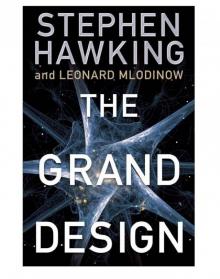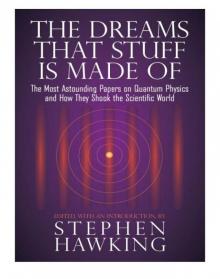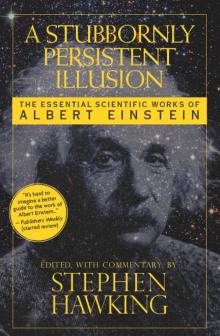- Home
- Stephen Hawking
A Stubbornly Persistent Illusion Page 34
A Stubbornly Persistent Illusion Read online
Page 34
If one views this phase of the development of theory critically, one is struck by the dualism which lies in the fact that the material point in Newton’s sense and the field as continuum are used as elementary concepts side by side. Kinetic energy and field-energy appear as essentially different things. This appears all the more unsatisfactory inasmuch as, according to Maxwell’s theory, the magnetic field of a moving electric charge represents inertia. Why not then total inertia? Then only field-energy would be left, and the particle would be merely an area of special density of field-energy. In that case one could hope to deduce the concept of the mass-point together with the equations of the motion of the particles from the field equations—the disturbing dualism would have been removed.
H. A. Lorentz knew this very well. However, Maxwell’s equations did not permit the derivations of the equilibrium of the electricity which constitutes a particle. Only other, nonlinear field equations could possibly accomplish such a thing. But no method existed by which this kind of field equations could be discovered without deteriorating into adventurous arbitrariness. In any case one could believe that it would be possible by and by to find a new and secure foundation for all of physics upon the path which had been so successfully begun by Faraday and Maxwell. - - -
Accordingly, the revolution begun by the introduction of the field was by no means finished. Then it happened that, around the turn of the century, independently of what we have just been discussing, a second fundamental crisis set in, the seriousness of which was suddenly recognized due to Max Planck’s investigations into heat radiation (1900). The history of this event is all the more remarkable because, at least in its first phase, it was not in any way influenced by any surprising discoveries of an experimental nature.
On thermodynamic grounds Kirchhoff had concluded that the energy density and the spectral composition of radiation in a Hohlraum, surrounded by impenetrable walls of the temperature T, would be independent of the nature of the walls. That is to say, the nonchromatic density of radiation is a universal function of the frequency v and of the absolute temperature T. Thus arose the interesting problem of determining this function (v, T) What could theoretically be ascertained about this function? According to Maxwell’s theory the radiation had to exert a pressure on the walls, determined by the total energy density. From this Boltzmann concluded by means of pure thermodynamics, that the entire energy density of the radiation () is proportional to T4. In this way he found a theoretical justification of a law which had previously been discovered empirically by Stefan, i.e., in this way he connected this empirical law with the basis of Maxwell’s theory. Thereafter, by way of an ingenious thermodynamic consideration, which also made use of Maxwell’s theory, W. Wien found that the universal function of the two variables v and T would have to be of the form
whereby f (v/T) is a universal function of one variable v/T only. It was clear that the theoretical determination of this universal function f was of fundamental importance—this was precisely the task which confronted Planck. Careful measurements had led to a very precise empirical determination of the function f. Relying on those empirical measurements, he succeeded in the first place in finding a statement which rendered the measurements very well indeed:
whereby h and k are two universal constants, the first of which led to quantum theory. Because of the denominator this formula looks a bit queer. Was it possible to derive it theoretically? Planck actually did find a derivation, the imperfections of which remained at first hidden, which latter fact was most fortunate for the development of physics. If this formula was correct, it permitted, with the aid of Maxwell’s theory, the calculation of the average energy E of a quasi-monochromatic oscillator within the field of radiation:
Planck preferred to attempt calculating this latter magnitude theoretically. In this effort, thermodynamics, for the time being, proved no longer helpful, and neither did Maxwell’s theory. The following circumstance was unusually encouraging in this formula. For high temperatures (with a fixed v) it yielded the expression
E = kT.
This is the same expression as the kinetic theory of gases yields for the average energy of a mass-point which is capable of oscillating elastically in one dimension. For in kinetic gas theory one gets.
E = (R/N)T,
whereby R means the constant of the equation of state of a gas and N the number of molecules per mol, from which constant one can compute the absolute size of the atom. Putting these two expressions equal to each other one gets
N = (R/k).
The one constant of Planck’s formula consequently furnishes exactly the correct size of the atom. The numerical value agreed satisfactorily with the determinations of N by means of kinetic gas theory, even though these latter were not very accurate.
This was a great success, which Planck clearly recognized. But the matter has a serious drawback, which Planck fortunately overlooked at first. For the same considerations demand in fact that the relation E = kT would also have to be valid for low temperatures. In that case, however, it would be all over with Planck’s formula and with the constant h. From the existing theory, therefore, the correct conclusion would have been: the average kinetic energy of the oscillator is either given incorrectly by the theory of gases, which would imply a refutation of [statistical] mechanics; or else the average energy of the oscillator follows incorrectly from Maxwell’s theory, which would imply a refutation of the latter. Under such circumstances it is most probable that both theories are correct only at the limits, but are otherwise false; this is indeed the situation, as we shall see in what follows. If Planck had drawn this conclusion, he probably would not have made his great discovery, because the foundation would have been withdrawn from his deductive reasoning.
Now back to Planck’s reasoning. On the basis of the kinetic theory of gases Boltzmann had discovered that, aside from a constant factor, entropy is equivalent to the logarithm of the “probability” of the state under consideration. Through this insight he recognized the nature of courses of events which, in the sense of thermodynamics, are “irreversible.” Seen from the molecular-mechanical point of view, however, all courses of events are reversible. If one calls a molecular-theoretically defined state a microscopically described one, or, more briefly, micro-state, and a state described in terms of thermodynamics a macro-state, then an immensely large number (Z) of states belong to a macroscopic condition. Z then is a measure of the probabality of a chosen macro-state. This idea appears to be of outstanding importance also because of the fact that its usefulness is not limited to microscopic description on the basis of mechanics. Planck recognized this and applied the Boltzmann principle to a system which consists of very many resonators of the same frequency v. The macroscopic situation is given through the total energy of the oscillation of all resonators, a micro-condition through determination of the (instantaneous) energy of each individual resonator. In order then to be able to express the number of the micro-states belonging to a macro-state by means of a finite number, he [Planck] divided the total energy into a large but finite number of identical energy-elements ε and asked: in how many ways can these energy-elements be divided among the resonators. The logarithm of this number, then, furnishes the entropy and thus (via thermodynamics) the temperature of the system. Planck got his radiation-formula if he chose his energy-elements ε of the magnitude ε = hv. The decisive element in doing this lies in the fact that the result depends on taking for ε a definite finite value, i.e., that one does not go to the limit ε = 0. This form of reasoning does not make obvious the fact that it contradicts the mechanical and electrodynamic basis, upon which the derivation otherwise depends. Actually, however, the derivation presupposes implicitly that energy can be absorbed and emitted by the individual resonator only in “quanta” of magnitude hv, i.e., that the energy of a mechanical structure capable of oscillations as well as the energy of radiation can be transferred only in such quanta—in contradiction to the laws of mechanics and electrodynamics.
The contradiction with dynamics was here fundamental; whereas, the contradiction with electrodynamics could be less fundamental. For the expression for the density of radiation-energy, although it is compatible with Maxwell’s equations, is not a necessary consequence of these equations. That this expression furnishes important average-values is shown by the fact that the Stefan-Boltzmann law and Wien’s law, which are based on it, are in agreement with experience.
All of this was quite clear to me shortly after the appearance of Planck’s fundamental work; so that, without having a substitute for classical mechanics, I could nevertheless see to what kind of consequences this law of temperature-radiation leads for the photo-electric effect and for other related phenomena of the transformation of radiation-energy, as well as for the specific heat of (especially) solid bodies. All my attempts, however, to adapt the theoretical foundation of physics to this [new type of] knowledge failed completely. It was as if the ground had been pulled out from under one, with no firm foundation to be seen anywhere, upon which one could have built. That this insecure and contradictory foundation was sufficient to enable a man of Bohr’s unique instinct and tact to discover the major laws of the spectral lines and of the electron-shells of the atoms together with their significance for chemistry appeared to me like a miracle—and appears to me as a miracle even today. This is the highest form of musicality in the sphere of thought.
My own interest in those years was less concerned with the detailed consequences of Planck’s results, however important these might be. My major question was: What general conclusions can be drawn from the radiation-formula concerning the structure of radiation and even more generally concerning the electro-magnetic foundation of physics? Before I take this up, I must briefly mention a number of investigations which relate to the Brownian motion and related objects (fluctuation-phenomena) and which in essence rest upon classical molecular mechanics. Not acquainted with the earlier investigations of Boltzmann and Gibbs, which had appeared earlier and actually exhausted the subject, I developed the statistical mechanics and the molecular-kinetic theory of thermodynamics which was based on the former. My major aim in this was to find facts which would guarantee as much as possible the existence of atoms of definite finite size. In the midst of this I discovered that, according to atomistic theory, there would have to be a movement of suspended microscopic particles open to observation, without knowing that observations concerning the Brownian motion were already long familiar. The simplest derivation rested upon the following consideration. If the molecular-kinetic theory is essentially correct, a suspension of visible particles must possess the same kind of osmotic pressure fulfilling the laws of gases as a solution of molecules. This osmotic pressure depends upon the actual magnitude of the molecules, i.e., upon the number of molecules in a gram-equivalent. If the density of the suspension is inhomogeneous, the osmotic pressure is inhomogeneous, too, and gives rise to a compensating diffusion, which can be calculated from the well known mobility of the particles. This diffusion can, on the other hand, also be considered as the result of the random displacement—unknown in magnitude originally—of the suspended particles due to thermal agitation. By comparing the amounts obtained for the diffusion current from both types of reasoning one reaches quantitatively the statistical law for those displacements, i.e., the law of the Brownian motion. The agreement of these considerations with experience together with Planck’s determination of the true molecular size from the law of radiation (for high temperatures) convinced the sceptics, who were quite numerous at that time (Ostwald, Mach) of the reality of atoms. The antipathy of these scholars towards atomic theory can indubitably be traced back to their positivistic philosophical attitude. This is an interesting example of the fact that even scholars of audacious spirit and fine instinct can be obstructed in the interpretation of facts by philosophical prejudices. The prejudice— which has by no means died out in the meantime—consists in the faith that facts by themselves can and should yield scientific knowledge without free conceptual construction. Such a misconception is possible only because one does not easily become aware of the free choice of such concepts, which, through verification and long usage, appear to be immediately connected with the empirical material.
The success of the theory of the Brownian motion showed again conclusively that classical mechanics always offered trustworthy results whenever it was applied to motions in which the higher time derivatives of velocity are negligibly small. Upon this recognition a relatively direct method can be based which permits us to learn something concerning the constitution of radiation from Planck’s formula. One may conclude in fact that, in a space filled with radiation, a (vertically to its plane) freely moving, quasi monochromatically reflecting mirror would have to go through a kind of Brownian movement, the average kinetic energy of which equals (R/N)T(R = constant of the gas-equation for one gram-molecule, N equals the number of the molecules per mol, T = absolute temperature). If radiation were not subject to local fluctuations, the mirror would gradually come to rest, because, due to its motion, it reflects more radiation on its front than on its reverse side. However, the mirror must experience certain random fluctuations of the pressure exerted upon it due to the fact that the wave-packets, constituting the radiation, interfere with one another. These can be computed from Maxwell’s theory. This calculation, then, shows that these pressure variations (especially in the case of small radiation-densities) are by no means sufficient to impart to the mirror the average kinetic energy (R/N)T. In order to get this result one has to assume rather that there exists a second type of pressure variations, which can not be derived from Maxwell’s theory, which corresponds to the assumption that radiation energy consists of indivisible point-like localized quanta of the energy hv (and of momentum (hv/c), (c = velocity of light)), which are reflected undivided. This way of looking at the problem showed in a drastic and direct way that a type of immediate reality has to be ascribed to Planck’s quanta, that radiation must, therefore, possess a kind of molecular structure in energy, which of course contradicts Maxwell’s theory. Considerations concerning radiation which are based directly on Boltzmann’s entropy-probability-relation (probability taken equal to statistical temporal frequency) also lead to the same result. This double nature of radiation (and of material corpuscles) is a major property of reality, which has been interpreted by quantum-mechanics in an ingenious and amazingly successful fashion. This interpretation, which is looked upon as essentially final by almost all contemporary physicists, appears to me as only a temporary way out; a few remarks to this [point] will follow later. - - -
Reflections of this type made it clear to me as long ago as shortly after 1900, i.e., shortly after Planck’s trailblazing work, that neither mechanics nor electrodynamics could (except in limiting cases) claim exact validity. By and by I despaired of the possibility of discovering the true laws by means of constructive efforts based on known facts. The longer and the more despairingly I tried, the more I came to the conviction that only the discovery of a universal formal principle could lead us to assured results. The example I saw before me was thermodynamics. The general principle was there given in the theorem: the laws of nature are such that it is impossible to construct a perpetuum mobile (of the first and second kind). How, then, could such a universal principle be found? After ten years of reflection such a principle resulted from a paradox upon which I had already hit at the age of sixteen: If I pursue a beam of light with the velocity c (velocity of light in a vacuum), I should observe such a beam of light as a spatially oscillatory electromagnetic field at rest. However, there seems to be no such thing, whether on the basis of experience or according to Maxwell’s equations. From the very beginning it appeared to me intuitively clear that, judged from the stand-point of such an observer, everything would have to happen according to the same laws as for an observer who, relative to the earth, was at rest. For how, otherwise, should the first observer know, i.e., be able to determine, that he is in a state of fast un
iform motion?
One sees that in this paradox the germ of the special relativity theory is already contained. Today everyone knows, of course, that all attempts to clarify this paradox satisfactorily were condemned to failure as long as the axiom of the absolute character of time, viz., of simultaneity, unrecognizedly was anchored in the unconscious. Clearly to recognize this axiom and its arbitrary character really implies already the solution of the problem. The type of critical reasoning which was required for the discovery of this central point was decisively furthered, in my case, especially by the reading of David Hume’s and Ernst Mach’s philosophical writings.
One had to understand clearly what the spatial co-ordinates and the temporal duration of events meant in physics. The physical interpretation of the spatial co-ordinates presupposed a fixed body of reference, which, moreover, had to be in a more or less definite state of motion (inertial system). In a given inertial system the co-ordinates meant the results of certain measurements with rigid (stationary) rods. (One should always be conscious of the fact that the presupposition of the existence in principle of rigid rods is a presupposition suggested by approximate experience, but which is, in principle, arbitrary.) With such an interpretation of the spatial co-ordinates the question of the validity of Euclidean geometry becomes a problem of physics.

 The Grand Design
The Grand Design A Brief History of Time
A Brief History of Time The Dreams That Stuff is Made of
The Dreams That Stuff is Made of My Brief History
My Brief History A Briefer History of Time
A Briefer History of Time A Stubbornly Persistent Illusion
A Stubbornly Persistent Illusion George and the Blue Moon
George and the Blue Moon George and the Unbreakable Code
George and the Unbreakable Code Brief Answers to the Big Questions
Brief Answers to the Big Questions George's Secret Key to the Universe
George's Secret Key to the Universe